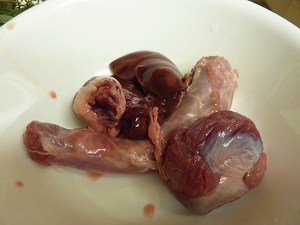
Did you know that about 45 million turkeys are killed every year in the U.S. for Thanksgiving?
Perhaps you already knew that and feel a bit uncomfortable about it.
And in your bid to stop needless waste you want to use as much of the turkey as you possibly can.
Which is why a question that pops into your head is “can my dog eat turkey neck?”
The short answer is that, of course, your dog can eat turkey neck.
And the remainder of the article will outline why turkey necks, if prepared properly for your dog, are an excellent choice of snack.
What nutrition do turkey necks contain?
As you would expect for a piece of meat, turkey necks pack a punch when it comes to protein, fat, cholesterol and seem to contain a huge dose of sodium.
Let’s put some numbers on those.
Your average portion of turkey necks (now that is an odd phrase if ever there was one) is about 22% protein and 7 % fat.
It is harder to explain just how much cholesterol and sodium turkey necks contain because the raw numbers will be a bit meaningless.
For instance a 135g portion of turkey neck contains 171 mg of cholesterol and 764 mg of sodium (salt.)
I might as well be speaking goobledygook, right?
It makes more sense if I explain it in terms of the recommended daily amounts that humans should consume.
Which again is less than perfect because this is an article about dogs.
But at least it will give us a rough approximation.
The amount of cholesterol in a portion of turkey neck contains approximately 57% of the recommended daily allowance for an adult human.
And in case you are wondering about what harm high levels of cholesterol can cause dogs, read this.
Now the salt value just baffles me. Meats don’t normally contain such high levels of sodium so I’m guessing that this value comes from table salt which has been added to the necks as they have been cooked.
And get this.
A 135g serving of turkey neck contains 33% of the salt that a person should eat in a day.
Ludicrous right?
So far the nutritional news has been a bit grim, as I’m sure that you would agree.
So let’s try and brighten things up shall we?
Turkey necks provide some large doses of lots of B vitamins (such as B2, B3, B6 and B12) which are the vitamins that help our dogs to maintain healthy cells.
Mineral wise, turkey necks contain lots of selenium (great for thyroids and DNA production) and zinc (which will boost your dog’s immune system.)
So having listed the nutritional pros and cons of eating turkey necks, I next want to talk about the best way that they can be prepared for your dog.
Raw vs cooked vs dehydrated- which is safer?
Your three standard options are raw, cooked or dehydrated.
And none of these options are totally risk free.
Raw turkey necks might contain harmful bacteria, whereas cooking the necks to kill the bacteria will also make the tiny bones which are inside the necks a choking hazard.
Dehydrated necks don’t need to be stored in the fridge or freezer which is convenient but because they are cooked and then dehydrated they come with all of the disadvantages of cooked turkey necks.
Life is never easy is it?
Most of us know about chicken and salmonella but far fewer of us know that the risks are almost as great with turkey.
If feeding them a raw turkey neck might result in them catching salmonella or clostridium it seems a bit of a “no brainer” to opt for the cooked option.
And you don’t need a fancy recipe with lots of seasoning because your dog won’t appreciate all of the different flavours and some of them might poison your dog.
You just need the fastest and easiest way to cook the necks so that their internal temperature hits 165 C- which is the magic number at which nasties such as salmonella are killed.
The trouble with cooking the neck is that the tiny neck bones become a far bigger choking hazard to a dog.
This is because cooking any type of animal bone makes it much harder which as far as neck bones are concerned means that they are more likely to get stuck in a dog’s throat than raw turkey bones.
So that just leaves us with the dehydrated option.
As I said earlier dehydrated turkey necks are cooked necks which are then allowed to air dry.
The same drawbacks apply.
So, what will the convenience of not having to store the dehydrated versions in the fridge going to cost?
Well on this site 5 lbs of raw turkey necks (the pack seems to contain six necks) will cost you $30 (although the price is reduced at the moment) whereas this site is offering individual dehydrated necks for just over $4 each.
Neither of those two prices include shipping.
Having discussed the thorny issue of how you should best “prepare” turkey necks for a dog, in the next section I will look at how turkey necks compare to other animal necks.
And what a tasty treat that will be for you!
Chicken vs turkey vs duck necks: which are more nutritious?
Although the focus of the article is on turkey necks, there are other animal necks which are available on sites that sell dog food.
And the two which are most commonly available are chicken necks and duck necks.
But how do they compare nutritionally?
| 100 g serving | Duck Neck | Turkey Neck | Chicken Neck |
| Calories | 130 | 130 | 157 |
| Fat | 5 g | 6 g | 11 g |
| Cholesterol | 0 mg | 0 mg | O mg |
| Protein | 19 g | 20 g | 15 g |
As you can see from the chart, any differences between the three different neck meats are marginal.
In fact, duck and turkey are almost the same.
Chicken has about 25% more calories and almost double the fat content of the other two meats but it also has about 25% less protein in it.
With so little difference, you are free to choose any of these neck meats .
But what is availability like?
Well that is a hard one because this article was written in one day and so any websites that I refer to will only be viewed on that day.
So my snapshot is very limited.
But on this website, duck, turkey and chicken necks are all available.
Chicken necks are around $25, turkey necks $30 and duck necks $35.
Whereas this site only has chicken checks and duck necks.
The freeze dried chicken necks and duck necks both start at $12 for 4.
Having looked at how you can get your hands on some and having already discussed that turkey necks are primarily bought as a tasty chew for dogs, in the next section I will look at what should happen if your dog doesn’t chew but swallows a neck whole.
Help! My dog swallowed a turkey neck whole
This article has already mentioned the fact that turkey necks contain little bones.
Now any bone has the potential to be a choking hazard to a dog because even when they are raw bones are hard objects.
If your dog has just got so over excited and swallowed a turkey neck then they could land themself in a whole heap of trouble.
Turkey necks are big objects far bigger than most dog’s throats are, which is why they need to be chewed so that only small bits at any one time are being swallowed by a dog.
Not only do the bones in a turkey’s neck present a danger to a dog but so does the meat, if it is swallowed whole.
Most of the meat in a turkey neck is muscle meat- the neck needs to be strong in order to balance the weight of the bird’s head.
Muscle meat is tough and full of sinew which makes it harder to swallow because it doesn’t break apart like other softer meats do.
The immediate danger of a dog swallowing a whole neck is that they might choke and the symptoms to be on the look out here are the obvious.
Choking, retching or vomiting hopefully with the happy end result being that the almost whole neck comes back up…
Importantly for you and your dog it will be crucial to not let it happen again.
And I will provide some hints on how to do this in a later section where I talk about puppies.
But next up, I want to talk about frozen necks.
Is it safe to feed frozen turkey necks to dogs?
Most raw food that is delivered to your door in the UK and the US is delivered frozen and this includes raw treats such as turkey necks.
But the food isn’t delivered frozen because that is the best way of feeding it to dogs, it is delivered frozen because it is the best way to keep the food fresh.
And this begs the question about whether we can skip a step and feed these frozen treats to our dogs?
Should we bother about trying to defrost our frozen turkey necks?
And, I would say that as tempting as it is, we should defrost the turkey necks.
And this is for two reasons.
Firstly, harking back to a point made earlier, frozen turkey necks for some dogs will be a real choking hazard and secondly frozen food will be rock hard and if a dog doesn’t choke on it, they might break a tooth on it.
So if you shouldn’t feed your dog frozen necks, are fresh turkey necks appropriate for puppies?
Let’s find out.
Are turkey necks safe for puppies to eat?
I don’t think that there is anything wrong with feeding a puppy turkey necks as long as it is done carefully.
Age wise, I would say that 4 months is a good place to start.
By this age the puppy would have had a couple of months of being fed puppy food, to get familiar with what their staple diet consists of..
and their digestion system will have had a little time to mature a bit.
Apart from that my only other advice would be to cut the neck up into small chunks before you feed it to them.
This gives you the chance to feed them less neck and it gives you the chance to observe how they eat it.
Most importantly, will they chew on the little bits or will they try to “down them in one”?
Can a dog eat turkey giblets?
Having spent so much of this article with a laser type focus on turkey necks I want to end it by thinking of another part of a turkey that your dog might find delicious.
Yes, ladies and gentlemen, turkeys have other body parts apart from necks, I’ll have you know.
And the other part is the turkey giblets.
Now, the neck forms part of the turkey giblet but other parts of it are the heart, gizzard and liver.
And all of these are perfect for your dog to eat with a few considerations to bear in mind.
In order to be safe, just cook these parts.
Don’t be tempted to feed them raw.
And secondly just be aware that liver is a very rich meat because it contains so much iron and vitamin A- huge quantities.
But this shouldn’t be a problem if you are just feeding your dog the giblets from one turkey.
It might be a problem if you own a turkey farm and you are thinking of adding giblets to your dog’s diet everyday!





